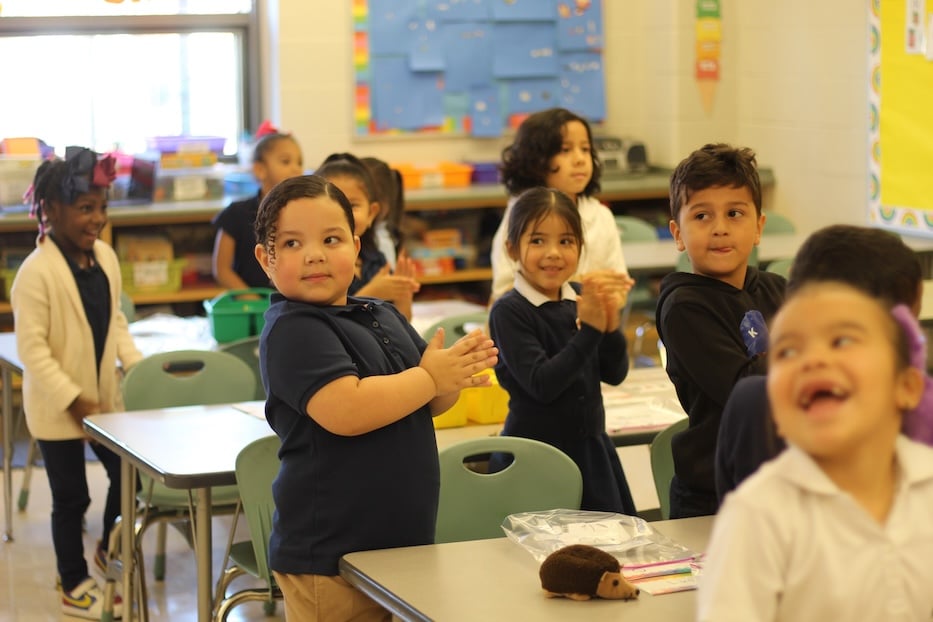
Culture & Community | Arts & Culture | New Haven Public Schools | Shubert Theatre
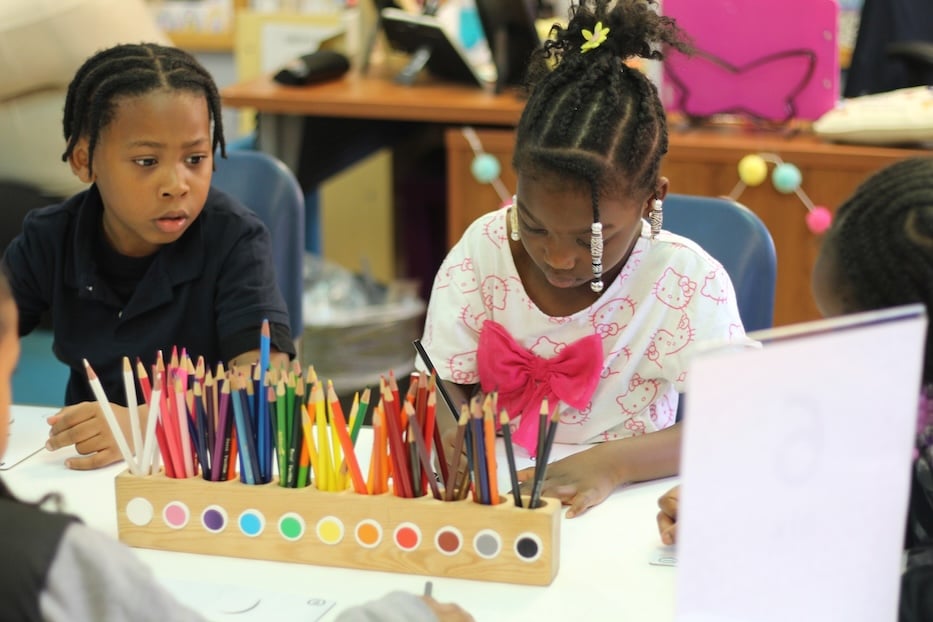
Second grader Olivia David, who said she was excited to see more live theater in the year ahead. Lucy Gellman Photo.
Seven-year-old Olivia David reached for a purple colored pencil, one eye lingering on a projection at the front of the room. On the screen, star usher Lucille Swepston looked out onto the Shubert Theatre, ready to get to work. Back in her seat, Olivia leaned over the black outline of Swepston’s head, and began to fill in her hair. It was a shade just lighter than amethyst, gem-like and royal as it fell around her ears.
“She’s pretty,” Olivia observed as the drawing took shape. Beneath her cropped purple locks, this version of Lucille rocked a flowy black jumpsuit with a blue tie and narrow belt. By the end of the hour, she was in good company, surrounded by drawings of ballerinas, Elphaba and Glinda, and audience members in plush red chairs.
Olivia is a student at Hill Central Music Academy, one of three schools where the Shubert Theatre has kicked off a new $1.2 million initiative to get theater into the New Haven Public Schools. Funded by the tech company ASML, the program aims to meet young audiences where they are, first by introducing them to the performing arts, and then with a new work of children’s theater devised and performed by students at Southern Connecticut State University (SCSU).
That performance will come in the spring (hold tight for more reporting from SCSU). This fall, the Shubert is starting its outreach with kindergarten through second grade students at Barack Obama Magnet University School, Bishop Woods Architecture & Design Magnet School, and Hill Central Music Academy.
It is one of two ways the theater is growing its educational footprint: it has also expanded programming with the New Haven Free Public Library, thanks to $12,000 from donor Lindy Lee Gold and her Amour Propre Fund. More on that below.
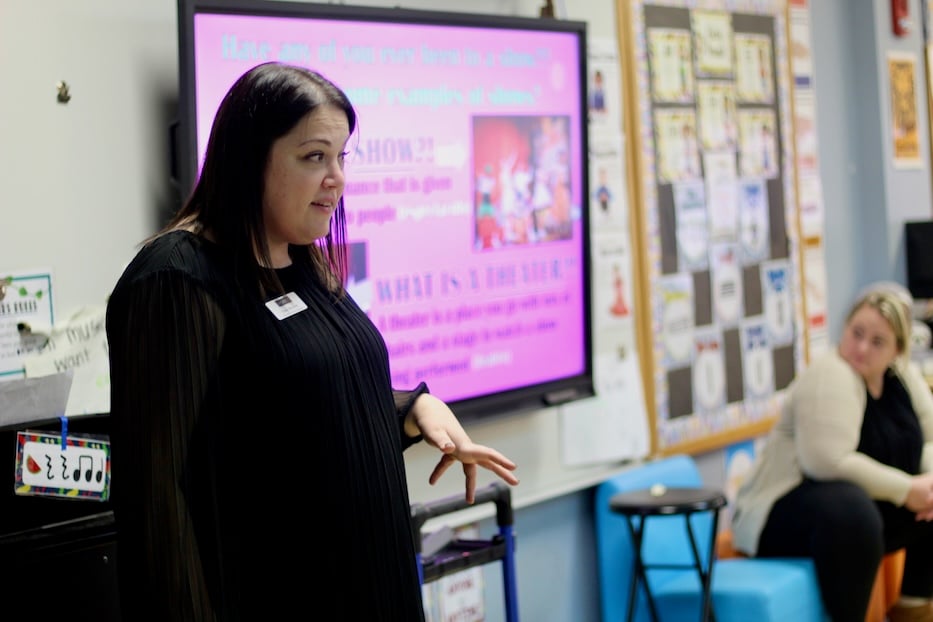
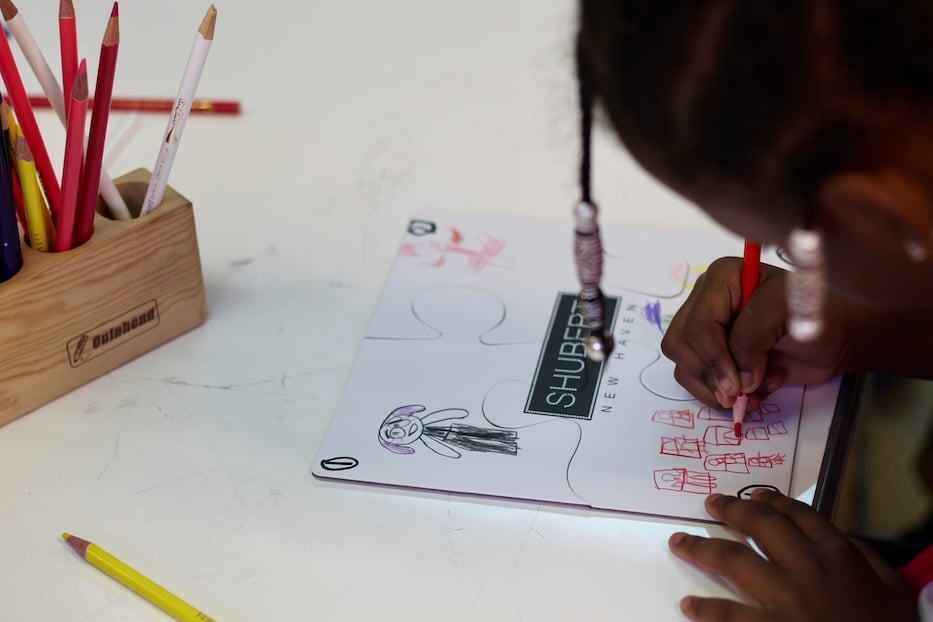
Top: Tracy Stratton, education programs manager at the Shubert Theatre, at Hill Central Music Academy later in the day. Bottom: Olivia David's creative work in action.
“I hope that with this program, we are able to give kids a look into theater,” said Education Programs Manager Tracy Stratton after the first week of teaching, noting that there are many reasons they may not otherwise have access to theater. “Theater is a safe place for so many kids, and it was a safe space for me too, and I hope that I’m able to instill a curiosity and love for theater … that will grow into a lifelong love.”
“Maybe we’ll have some future Tony winners out there,” she added.
Part of the program’s magic is Stratton herself, a former West Haven Public Schools teacher who is building the program from the ground up (credit is also due to Shubert Education and Engagement Director Kelly Wuzzardo, who for years has orchestrated library visits, master classes, tech breakfasts, educational collabs and youth programs on a nonexistent budget).
When she assumed her role earlier this year, Stratton was still dreaming up the ways she wanted to introduce students to the performing arts, with the knowledge that many of them had never been to a play. By last week, she’d built out a presentation on “the puzzle pieces of theater,” with moving parts to represent the four essential pillars of the performing arts.
Those include a theater’s staff, from an artistic director to ushers who may be the first faces an audience sees when they arrive; the crew members (stagehands, set and costume designers, makeup artists, prop managers, directors and dramaturgs) who keep the illusion going behind the scenes; characters, who transform from mere mortals to the giants of the stage; and the audience itself.
“I think teaching them how theater works, and how it’s not just what’s on stage, but also what is going on behind stage,” is powerful, Stratton said.
She takes her mission literally: Stratton doesn’t go anywhere without dozens of handheld puzzles, each of them sliced neatly into four jigsaw-like pieces and emblazoned with the Shubert’s logo. In classroom visits, she invites students to draw their own interpretations of each puzzle piece, using one applied art form to directly understand another (that’s not just anecdotal: kids are visual learners, and drawing is linked to better memory and recall). They always end with a self-portrait, a reminder that they have a place in the audience.
Building A Play
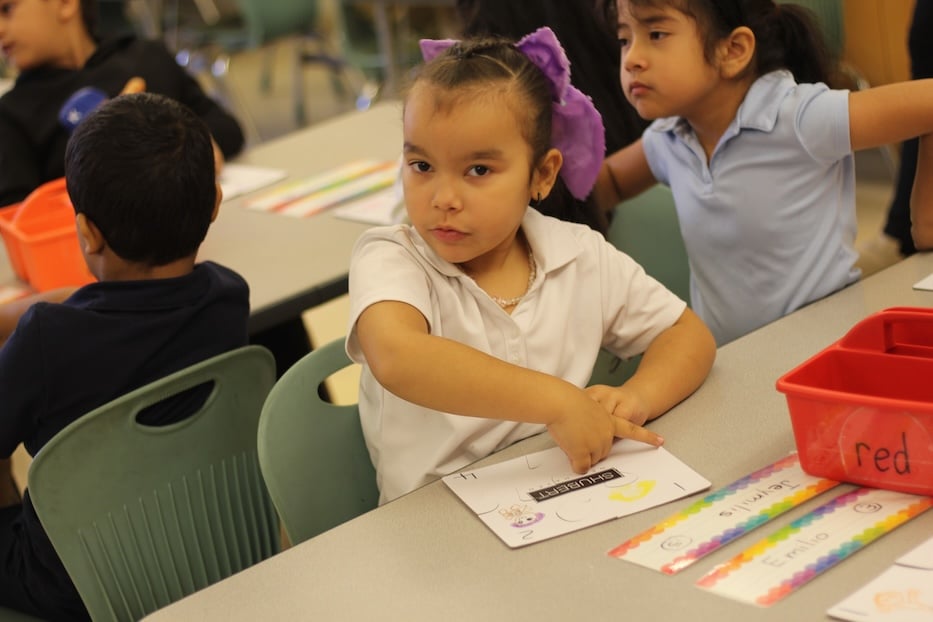
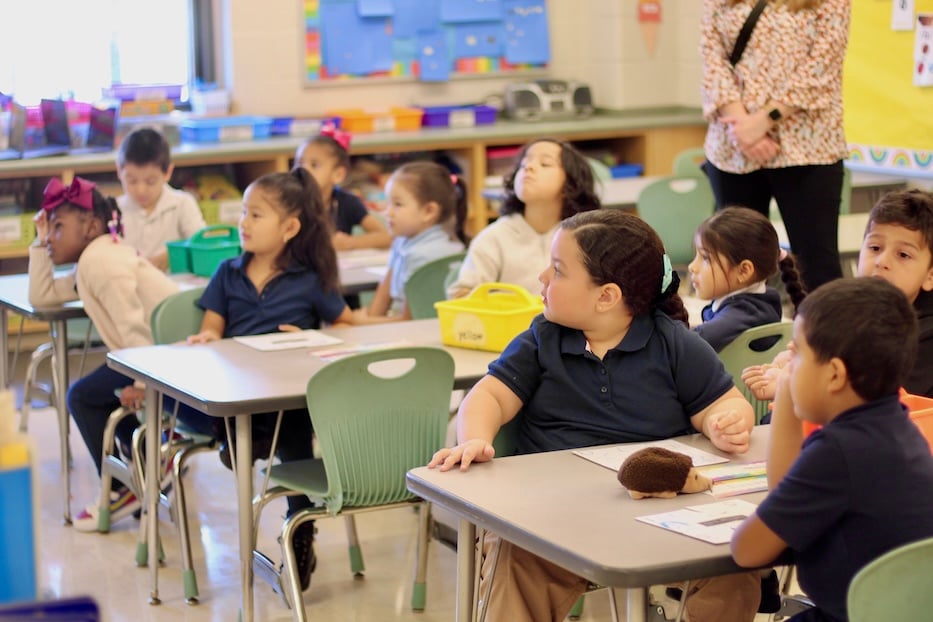
Top: Bishop Woods Kindergartner Jeymilis Velez works on her puzzle. Bottom: Students in Beth Wright's classroom.
As she made her way into a kindergarten classroom at Bishop Woods last week, Stratton harnessed a bright-eyed dynamism, ready to jump into the fundamentals of performance with a class of students for whom Bluey is a shining North Star. Around her, the school still seemed to be waking up: the hallways were quiet, the click-click of keyboards audible in the front office. Down a few doors, students in Beth Wright’s kindergarten class sat at their desks, ready for the day ahead.
Stratton, who is also a mom and embodies that all-encompassing, quintessentially mom energy, glided into the room with a kind of verve that is contagious, her voice ringing and rolling through the space. Around the room, students seemed to perk up: even a fuzzy, well-loved hedgehog on one of the desks appeared to be listening more intently. As she handed out puzzles and pulled up the presentation—“You ready? Okay!”–each student inspected the new task in front of them.
“Do you know what a show is?” Stratton started, motioning to several terms in Spanish—teatro, espectáculo—that she’d folded into the presentation. Behind her, the screen glowed pink behind the words Have any of you ever been to a show? What are some examples of shows? In a photograph beside the text, six actors danced across a stage, striking a pose as the lights glowed bright around them.
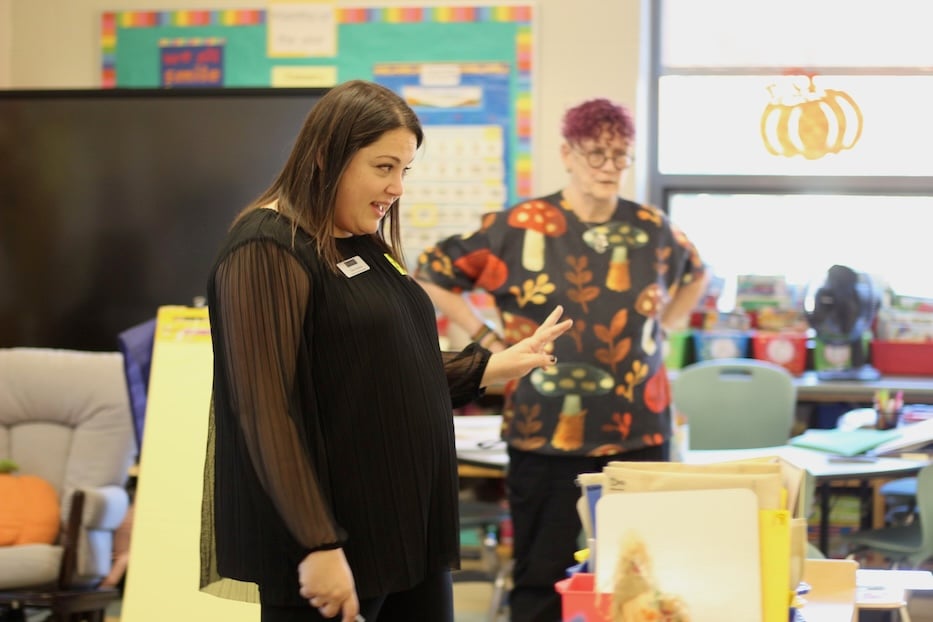
“What is a theater!?” Stratton asked as students sat up a little straighter, all of them focused on the front of the room. As a few offered answers—what about Gabby’s Dollhouse, suggested Nova Alvarado Reyes in a voice that barely registered—the room came alive. Wright, who has been at Bishop Woods for 20 years, made her way over to a desk where a student needed translation help, and crouched down to keep the discussion going.
In her seat, Nova squirmed eagerly, sketching out an image of an usher as Stratton guided students through the first puzzle piece—the people who make a theater run, whether there’s a play on stage or not. Around the room, images materialized: some students drew Stratton, including as an abstracted burst of bright yellow, others went for real-life Shubert ushers like Swepston.
“I want to go to a play,” Nova said quietly as she brushed her hand over the crisp puzzle, and awaited the next direction. “I never seen people performing.” As an especially big fan of Shrek (“the cat is so funny!”), she looked ready to melt into the floor minutes later, when Stratton shouted out makeup artists, and announced that she had played Princess Fiona in a live performance of the musical comedy. Thanks to crew members who knew what they were doing—and lots and lots of adhesive—she didn't lose her own nose in the process.
Back at the front of the classroom, Stratton was moving on to the second piece, guiding students to the upper righthand corner of the puzzle she’d handed out. She had just gotten into shouting out choreographers when she stopped and took a beat.
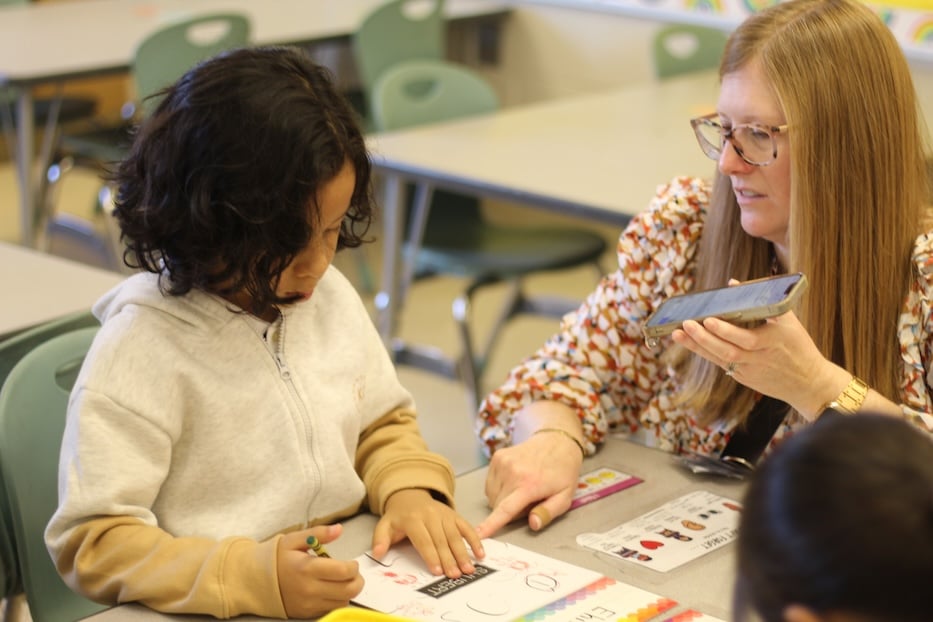
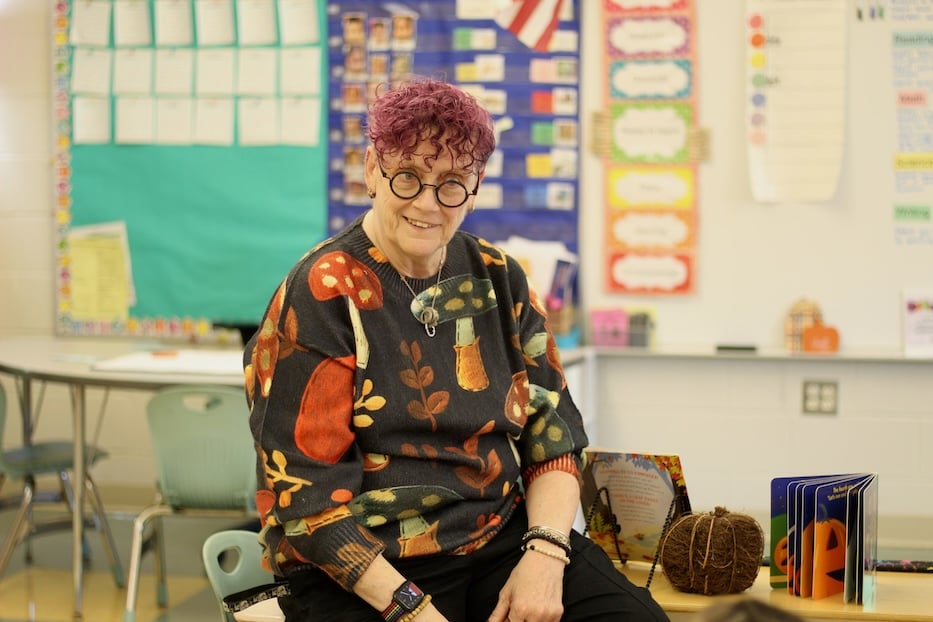
Top: Teacher Beth Wright gets a tech assist for translation help. Theater teacher Hope Flanigan, who some students opted to draw when they got to the second puzzle piece.
“Oh my gosh! I forgot about more people!” she said with the whimsy of Abby Cadabby. “There’s more people we gotta talk about. These—” she motioned in the direction of the screen “—are what we call the stagehands. These are what move everything back and forth backstage. So they work on the stage using their—”
“Hands!” students responded, with small voices that wove in and out of each other.
“So they call them stage hands,” Stratton finished. “They’re gonna move all the set pieces and everything! You can see, right here, a show going on, and people backstage getting all the magic, and pretty lights, and sound and special effects to happen.”
She held up the wireless remote in her hand and moved on to props. Hope Flanigan, who teaches drama at the school, hopped in to help.
“What about Little Red Riding Hood?” Flanigan asked. Flanigan later joked with students—many of whom drew her—that she’d been every person in Stratton’s presentation at one point or another.
“A basket!” students crowed back.
“So if Little Red Riding Hood was on a stage holding a basket, her basket would be a prop! Because it’s on stage!” Flanigan said. By the time she and Stratton made it back to lighting and sound, every eye was on the front of the room.
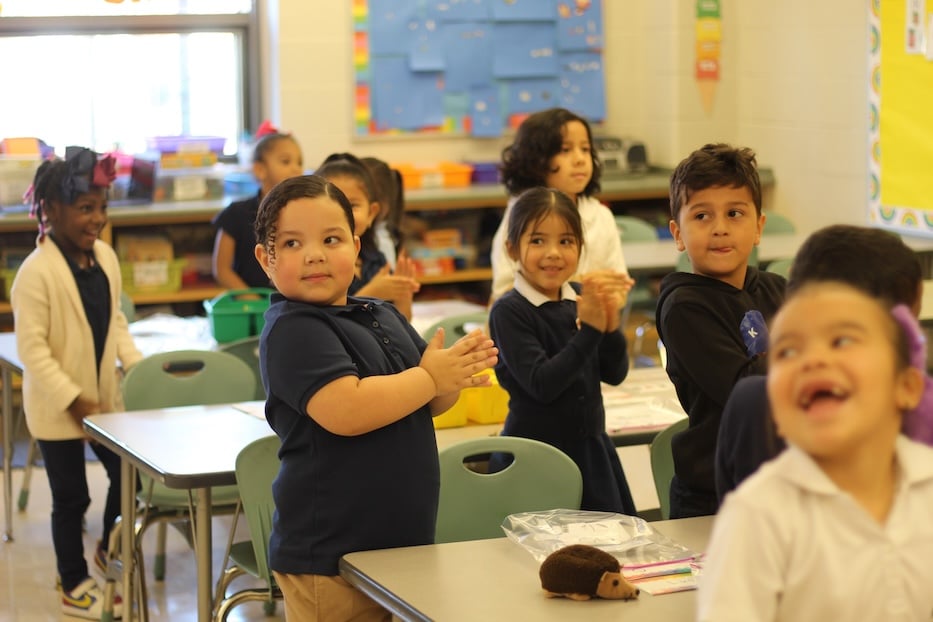
Nova Alvarado Reyes practices a standing ovation.
As students moved through the remaining puzzle pieces, Stratton guided them through the inner workings of a whole show, demystifying the magic of a performance one step at a time (many students, on the second puzzle piece, excitedly drew Flanigan as their own theatrical shero).
From the dramatic world-builders who keep a play going, Stratton flowed to the actors themselves, who bring a show to life. On screen, a couple leaned in, their faces close together, and Stratton explained that they weren’t really in love, but acting. She pointed to an image from Wicked, and the room filled with murmurs of delight.
Then, of course, there was the audience—“that’s you!”—that makes a play complete. In her classroom visits, each puzzle ends with a self-portrait, letting students know that they have a piece in the theater.
Before long, self-portraits populated every desk and table in the room (“Beautiful!” Stratton crooned at one point, and it sounded genuine enough to believe she was looking at the Mona Lisa). Before she left, she said, she needed to share one more pro tip for the theater.
“When you go to the theater, you need to be a student that is a B-R-A-V-O student!” she said.
“B!” Students cried back.
“Be on time when you go to a show!” she started. “R! Respect everyone around you! … Ask for help if you need it! Who do you ask for help if you need it? Do you remember?”
“Yeah!” students responded. “The audience!”
“You’re the audience!” Stratton said. “Who do you ask for help? Her name was Lucille! The ush—”
“Usher!” a student replied. “V!” the class shouted around him.
“Voices and devices off!” Stratton continued. “For everyone! And O! You give what we call in the theater a standing ovation if you loved the show.”
Before long, students were out of their chairs, clapping and cheering as Stratton took a bow to demonstrate. Emilio Cayancela, who had been quiet for most of the class, later said he was most excited to draw the actors, who reminded him of a nativity play he’d seen at church.
From Quinnipiac Meadows To The Hill
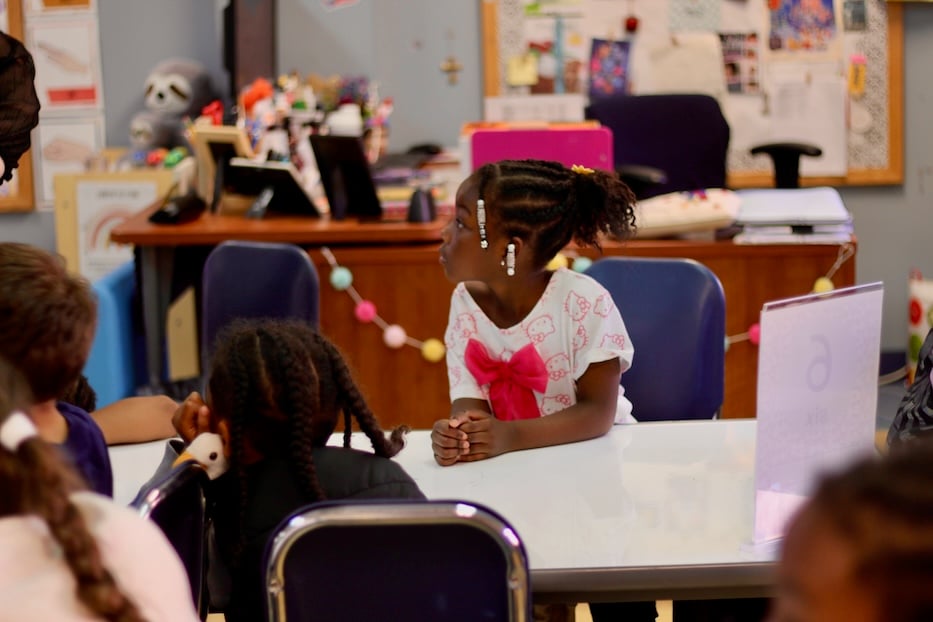
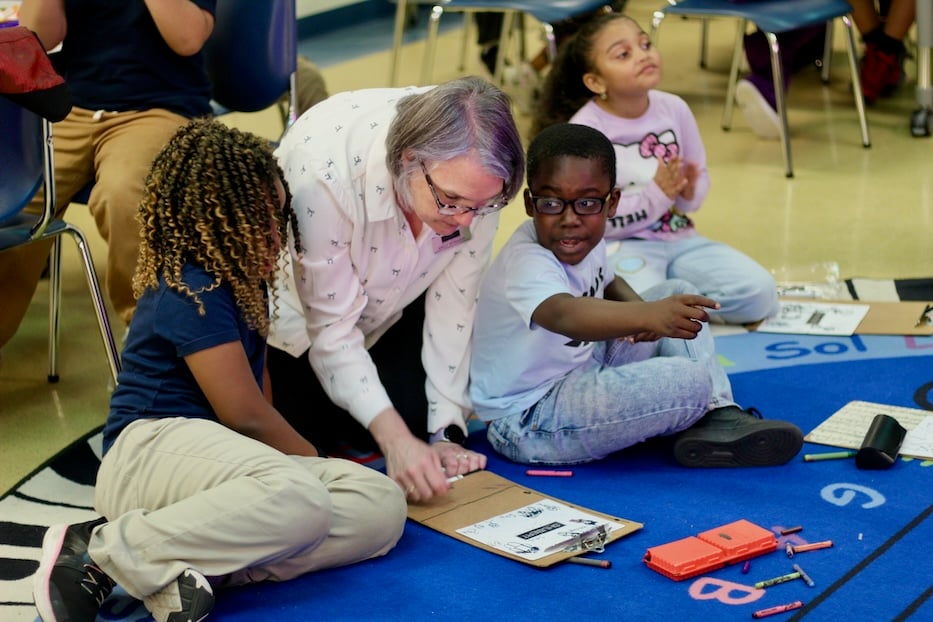
Top: Olivia David patiently waits for direction. Bottom: Shubert Director of Education and Engagement Kelly Wuzzardo lends a hand.
That energy flowed across town to Hill Central later that afternoon, as second graders streamed into the band classroom for the last class of the day. At the far end of the room, Olivia nearly vibrated with excitement. Two years ago, she and classmates went on a field trip to the Shubert to see 1,2,3 Andrés, the bilingual and musical brainchild of husband-wife duo Andrés Salguero and Christina Sanabria. She’s never forgotten how that show made her feel.
“I loved it!” she said. “They were saying funny stuff.” Their books, one of which she was able to go home with, help her speak “a little bit of Spanish” at home, she said. While her family primarily speaks English, the performance marked the first time that she’d thought about the importance of other languages in her life.
“Do you know what a show is?” Stratton started, flipping back to the same pink slide she’d pulled up that morning. She looked around to a class that was double the size as the one she’d had hours earlier. Wuzzardo, there as an extra set of hands, buzzed around the room. “Have you guys ever heard of Junie B. Jones?”
“Yeeeesssssss!” Olivia yelled back, the beads in her hair bouncing.
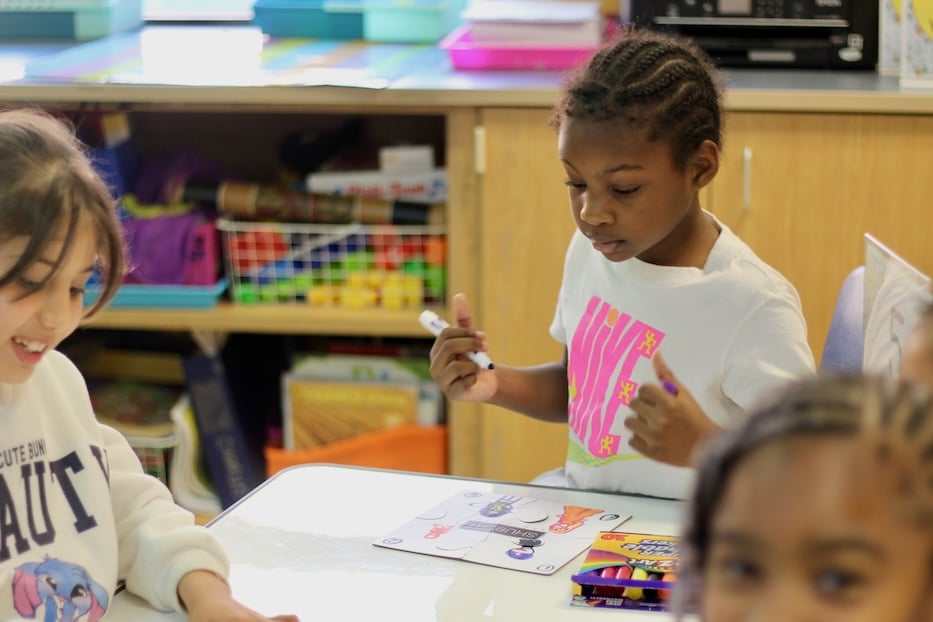
Samiyya May.
At the front of the room, Stratton moved through the same ballet, teasing out one dramatic thread at a time. For the second time in just a few hours, she found herself face-to-face with ushers from the theater like Swepston. Just as before, she described the people that keep a theater running, well before actors ever reach the stage. One cluster of desks over, Samiyaa May reached excitedly for red and purple markers, and got to work.
Like Olivia’s depiction of Swepston, this version also had purple hair (in real life, Swepston has grey-blonde hair cropped above her shoulders) and bright red lipstick. Stratton, taking a look at the drawings, held up her own puzzle, in which an usher was dressed in a neat black suit beside an oversized red-and-yellow ticket that read “Admit One.”
Back at her desk, Olivia was getting serious with her puzzle. As she listened to Stratton move through the parts of a show, she added a ballerina, then depictions of Glinda and Elphaba that made her smile as she described who was who (“I like Glinda better because she’s pretty,” she said when this reporter insisted that Elphaba was the star of the show). When it was time to add herself, she grabbed a red pencil, and began to draw the entire orchestra section.
“I like when they act, it makes me feel happy,” she said before learning about how to be a B-R-A-V-O student herself. “I learned stuff about the theater, like sitting down, listening, and when they’re done, standing up and clapping.”
“Theater Does More Than Entertain”
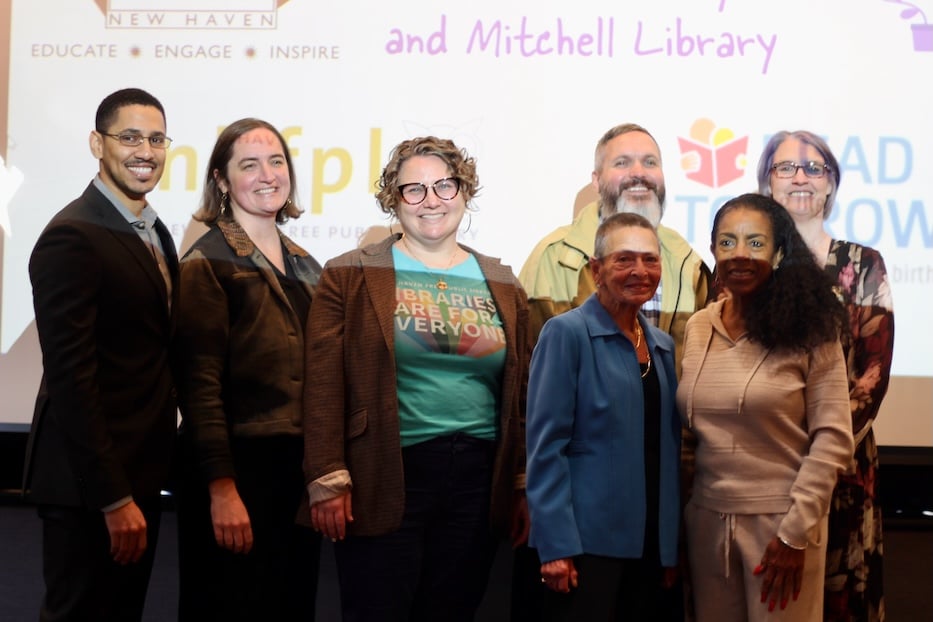
Shubert Executive Director Anthony McDonald, Read To Grow Executive Director Suzannah Holsenbeck, Mitchell Children's Librarian Sarah Quigley, Amour Propre President Lindy Lee Gold , Stetson Young Minds and Families Librarian Phillip Modeen, Stetson Branch Manager Diane Brown, and Shubert Director of Education and Engagement Kelly Wuzzardo.
As “Shubert In Motion” lifts off at schools this month, the theater is also growing its partnership with the New Haven Free Public Library, to bring more performance-adjacent programs out of the College Street building and into the community. For the past eight years, the theater has worked closely with the Stetson Branch Library, which is located in the city’s Dixwell neighborhood, to create free activities for kids and teens at the library (read about some of those here and here).
Now, with support from the Amour Propre Fund, Inc., the Shubert will be able to double that mission, expanding to the library’s Mitchell Branch in New Haven’s Westville neighborhood. At Stetson, those programs work with Young Minds and Family Librarian Phillip Modeen; at Mitchell, Children's Librarian Sarah Quigley is the main point of contact. The Shubert is also working with the literacy nonprofit Read To Grow, which provides free books for every child.
“As much as we can, we always want to bring families here, but that’s not always possible,” Wuzzardo said. “So this is bringing out a little piece of us to the neighborhoods. It’s easy to get to, totally free for families.”
The idea for support began over a year ago, when donor Lindy Lee Gold—who leads Amour Propre—funded Shubert programs at the Stetson Branch, to give kids some of the same access to theater that she had as a child growing up. Gold, who is a senior development specialist at the Connecticut Department of Economic and Community Development, grew up going to the Shubert, with “rockstar seats” thanks to a friend whose dad was in the theater business.
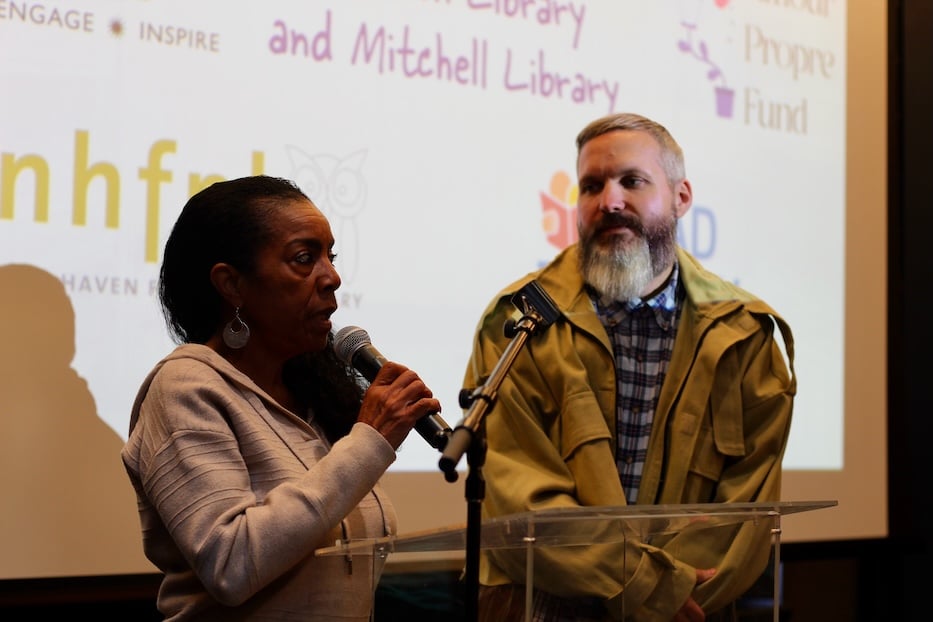
Stetson Branch Manager Diane Brown and Young Minds and Families Librarian Phillip Modeen. "There’s so many beautiful ways that we work, we partner together, and I’m very excited to see what we get to do going forward," he said.
For years, she didn’t think twice about it—until she was buying tickets for her own son, nieces and nephews, and grandchildren. While she is still an avid supporter of the performing arts—she attends almost every show in Connecticut, and some in New York too—she quickly realized how ticket prices can add up for families.
“Theater does more than entertain,” she said. “It builds community, it serves as a platform for social commentary and change, it builds connection. And when families go to these programs, it’s more meaningful because it builds conversation for them beyond their normal boundaries.”
Enter her support. For years, Wuzzardo had been running the program on a nonexistent budget, from hip-hop tutorials and paper ornaments to a gingerbread kit stocked with eggs, sugar, flour, and spices during the Covid-19 pandemic. With Modeen and Stetson Branch Manager Diane Brown, she helped run “Stetson on the Street,” a program that got the library into the community when its physical doors were still closed. Often, Modeen remembered, she struck him as game for anything.
“There’s so many beautiful ways that we work, we partner together, and I’m very excited to see what we get to do going forward,” Modeen said. In the past years, he’s been grateful to work with Wuzzardo on everything from storytime with ASL (American Sign Language) interpretation to events that teach kids new dance moves and send them home with books.
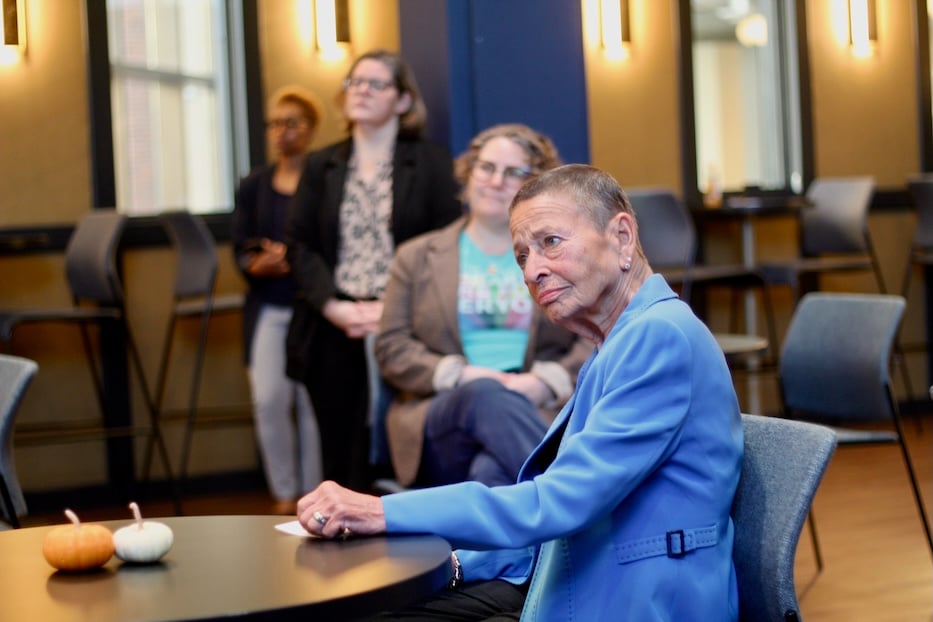
So this year, when Gold asked Wuzzardo what it would mean if she increased her gift, Wuzzardo already knew the answer. More funding—$6,000 for each branch, or about $1,500 per program—meant that Wuzzardo could add a library branch, pay more artists, load up on healthy snacks, fill more gift bags—and raffle off a four-pack of tickets to a family. Without that kind of giveaway, a family trip to the theater can run anywhere from $220 (that’s before tax) to $350, a number that is prohibitive for many Connecticut families.
“I know firsthand the amazing work the Subert has been doing, and growing, and expanding in the community,” said Read To Grow Executive Director Suzannah Holsenbeck, who for years served as the arts director at Cooperative Arts & Humanities High School. She stressed the importance of storytime for early literacy and childhood development. “I know so many former students of mine who have gone on to do incredible things at the Shubert that they wouldn’t have had anywhere else.”
Since 2015, the nonprofit has helped the Shubert-Stetson partnership get over 2,000 books into the community. Holsenbeck shouted out Books for Kids Co-Coordinator Linda Sylvester, who prepares a box of relevant books for Wuzzardo—complete with different age groups—when Wuzzardo puts out the call.
The programs start this Saturday, Nov. 1, with a poetry-themed hour around Thee Phantom & the Illharmonic Orchestra at Stetson at 2 p.m., followed by the same event at Mitchell the following Wednesday, Nov. 5, at 4 p.m. (the group performs at the Shubert on Nov. 22). In addition to library and theater staff, the hour will feature outgoing New Haven Poet Laureate Sharmont Influence-Little, who also performed at the Shubert’s season launch in September.
Then in February, they resume with an hour dedicated to Mrs. Doubtfire on the 7th and 11th of the month respectively. This season’s library programming concludes in March and April, with workshops designed around Step Afrika! and Dog Man The Musical.
With the influx of new funding, Wuzzardo said that one of the most exciting things she’s been able to do is pay teaching artists, rather than calling in favors or stretching the tiny budget her department has historically had to work with. Before Gold’s gift, Wuzzardo made the program work on a few hundred dollars, a lot of elbow grease, and some deep love for the community.
“We’re very proud to have this program,” Wuzzardo said. “We’re very grateful.”

